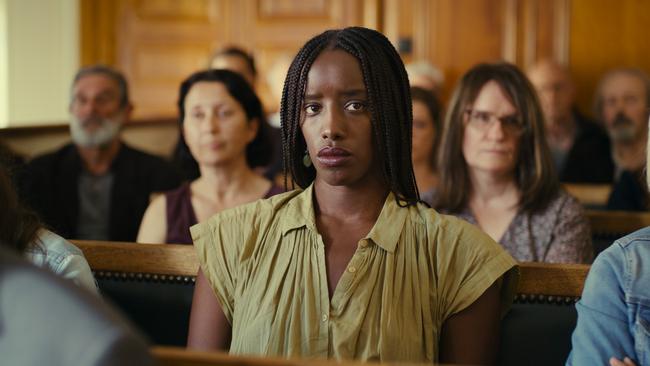Saint Omer: An intense exploration of motherhood and murder
Inspired by a harrowing true story, the experience of making Saint Omer was so intense, its director Alice Diop fainted on set.
New Movies
Don't miss out on the headlines from New Movies. Followed categories will be added to My News.
There is a strangled intensity to Saint Omer, a charged energy that makes you feel deeply uncomfortable.
That’s expected given the heavy subject matter of French-Senegalese documentarian Alice Diop’s first fictional feature. When the themes of motherhood and murder intersect, it’s a not an easy amble in a park.
Saint Omer is inspired by the real-life case of Fabienne Kabou, a Senegalese immigrant who was found guilty of killing her baby daughter by abandoning her to drown on a beach in Berck-sur-Mur in the north of France.
Diop, pregnant at the time, was drawn to the case and sat in the courtroom of Kabou’s trial in the town of Saint-Omer for a week, taking meticulous notes of both what was said and of her feelings and thoughts of everything that she felt the trial embodied – motherhood, womanhood, colonisation, race and the personal resonance of Kabou’s pained story and actions.

That week in Saint-Omer, three hours north of Paris, transformed into Saint Omer the film, which is out now in Australia after premiering at the Venice Film Festival in 2022, where it won the prestigious Grand Jury Prize.
The intensity of Diop’s time in that courtroom is channelled into the film, a stunning piece of art which Portrait of a Lady on Fire filmmaker Celine Sciamma described as a “dangerous and radiant” “cinema poem” to the New York Times.
The fictionalised story of the film centres on two women: Laurence Coly, Saint Omer’s stand-in for Kabou, accused of killing her 15-month-old daughter, and Rama, a writer who sits in on the court proceedings who’s interested in incorporating Laurence’s story into a modern reworking of Medea.
The movie was filmed in the same real courtroom Kabou’s trial took place while much of the dialogue of Laurence’s story on the stand was taken from Diop’s transcription of what Kabou said.
“The words in the trial are the actual words from the [Kabou] trial,” Guslagie Malanda, the actor who portrays Laurence, told news.com.au. “Those are the words. The documentary helps the fiction and then the fiction helps the documentary part of Saint Omer.”
The choice reflects Diop’s documentary background, as does the movie’s spare, modest approach. It allows the performances to be the focus.
It was a taxing, emotional experience.
Malanda said that when she was on the stand, it felt as if she was on trial. “I wasn’t defending the character, I was the character, it was as if I was defending myself. I was in my own trial for three weeks, every day.”
It’s no wonder Malanda had nightmares for a year.

The intensity of the experience also caused Diop to faint and collapse on the set, right at the end of shooting. She told the LA Times she was taken to hospital, and she felt that during the three weeks, she had birthed a monster.
But for all the intensity of the experience, Malanda said the production – and Diop especially – took excellent care of everyone.
“There was a benevolence and nurturing from Alice and her co-writers,” she said. “Their gaze, their benevolence, their care, it brought out the intensity.
“It disproves the idea that you have to be violent and really shake people up in order to create intensity. Because in cinema, you have all these stories about filmmakers or productions that are very intense in a bad way.
“But look at Saint Omer, there was an intensity and the movie is great, and [it wasn’t like that at all].”

Malanda and her co-star Kayije Kagame both worked with a famous choreographer and a tai chi master on breath exercises to be in sync and create a visceral connection to their characters.
But the two didn’t actually talk about the work until after production had wrapped. Kagame said, “It was better in that sense because that way, we were keeping a distance which helped create that distance between the characters”.
The characters share silences in the same space, but despite the resonance Rama felt to Laurence’s story, Malanda argued that among the ways Saint Omer comments on race is to have two black female characters who are so different to each other.
“They’re not interchangeable,” she said. “That may in fact be the anti-racist place of the film. Because the essence of racism is think that skin colour or religion or nationality is a whole. And Saint Omer is two women that have the same skin colour.
“They may both have an immigrant story, but they’re very different, very complex characters. And there is still a sense that there is a universality that can connect to other women all over the place, whatever their story is, through the subject of motherhood.”
Saint Omer is in cinemas now
The writer travelled to Paris as a guest of Unifrance
Originally published as Saint Omer: An intense exploration of motherhood and murder



